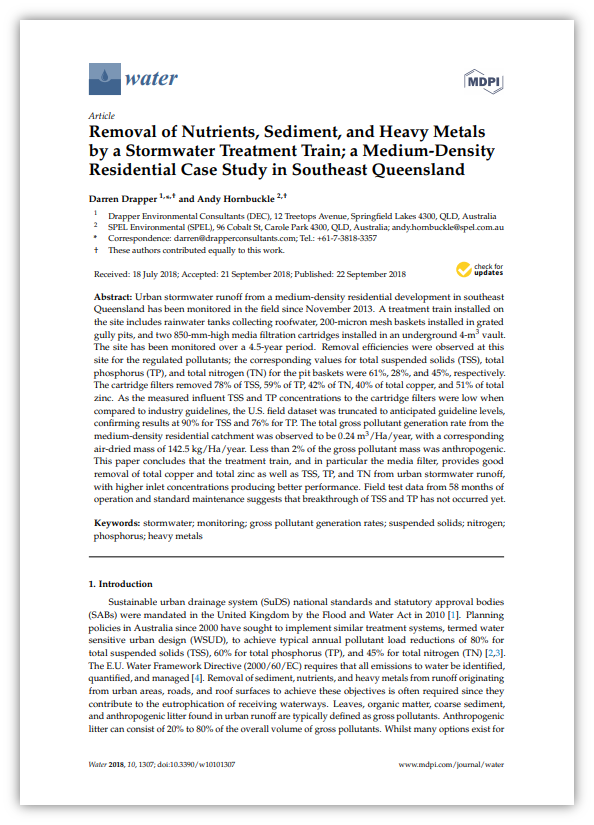This paper concludes that the treatment train, and in particular the media filter, provides good removal of total copper and total zinc as well as TSS, TP, and TN from urban stormwater runoff, with higher inlet concentrations producing better performance.
Authors
Darren Drapper 1,*,† and Andy Hornbuckle 2,†
- (1) Drapper Environmental Consultants (DEC), 12 Treetops Avenue, Springfield Lakes 4300, QLD, Australia
- (2) SPEL Stormwater (SPEL), 96 Cobalt St, Carole Park 4300, QLD, Australia; andy.hornbuckle@spel.co.nz
- (*) Correspondence: darren@drapperconsultants.com; Tel.: +61-7-3818-3357
- (†) These authors contributed equally to this work.
Abstract
Urban stormwater runoff from a medium-density residential development in southeast Queensland has been monitored in the field since November 2013. A treatment train installed on the site includes rainwater tanks collecting roofwater, 200-micron mesh baskets installed in grated gully pits, and two 850-mm-high media filtration cartridges installed in an underground 4-m3 vault. The site has been monitored over a 4.5-year period. Removal efficiencies were observed at this site for the regulated pollutants; the corresponding values for total suspended solids (TSS), total phosphorus (TP), and total nitrogen (TN) for the pit baskets were 61%, 28%, and 45%, respectively. The cartridge filters removed 78% of TSS, 59% of TP, 42% of TN, 40% of total copper, and 51% of total zinc. As the measured influent TSS and TP concentrations to the cartridge filters were low when compared to industry guidelines, the U.S. field dataset was truncated to anticipated guideline levels, confirming results at 90% for TSS and 76% for TP. The total gross pollutant generation rate from the medium-density residential catchment was observed to be 0.24 m3/Ha/year, with a corresponding air-dried mass of 142.5 kg/Ha/year. Less than 2% of the gross pollutant mass was anthropogenic. This paper concludes that the treatment train, and in particular the media filter, provides good removal of total copper and total zinc as well as TSS, TP, and TN from urban stormwater runoff, with higher inlet concentrations producing better performance. Field test data from 58 months of operation and standard maintenance suggests that breakthrough of TSS and TP has not occurred yet.
About Water – Open Access Journal
Water (ISSN 2073-4441; CODEN: WATEGH) is a peer-reviewed open-access journal on water science and technology, including the ecology and management of water resources, and is published monthly online by MDPI. Water has published this article. Read more.



